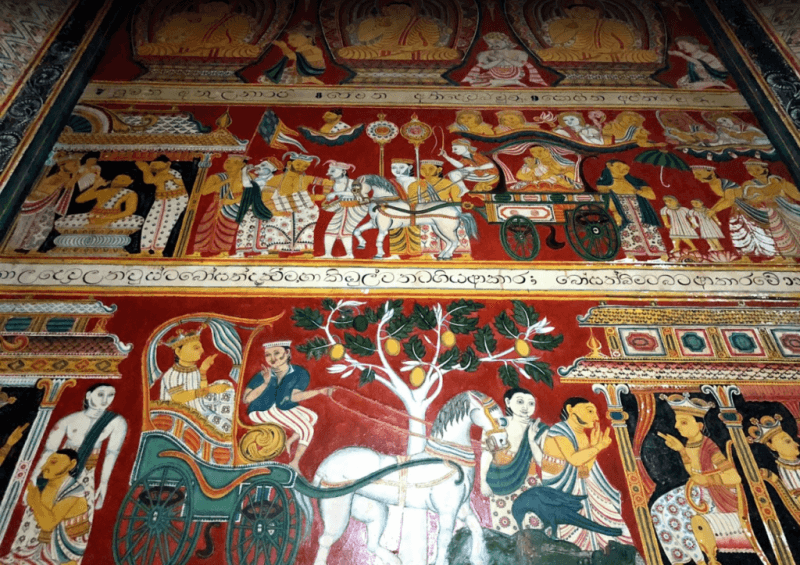
Degaldoruwa Raja Maha vihara
The city of Kandy and its surrounding is the stronghold of the Sri Lankan Buddhist community for many centuries. Kandy is still popular as a Buddhist city and the majority of people in Kandy are believing in Buddhism. Kandy is the most sacred City for Buddhist on the island due to the presence of tooth relic temple, which is visited by thousands of Buddhist pilgrims every day.
Kandy is in the bucket list of every traveller in Sri Lanka, not only because Kandy is a historical city with a large number of historical monuments but also it harbours many other important tourist places in Sri Lanka such as botanical gardens, rain forests, museums etc. Most Sri Lanka trips meant for foreign travellers include Kandy city tour.
Kandy is very easy to reach from Colombo and it takes only 3 hours to the drive to Kandy from Colombo. Therefore, Kandy is a popular day trip holiday spot in Sri Lanka. The travellers can visit important tourist places in Kandy from Most beach resorts on the west coast as well as Colombo on a one day tour.
Kandy was the last ruling capital of Sri Lanka kings. The kingship of Sri Lankan monarchy was ceded in 1815, with the apprehension of Kandy king By British army.
However, the dedication of people to their religion was intact, despite the fact that their king was expatriated to India. Many kings who ruled the island from Kandy had contributed to Buddhism in many ways. Most of them built new temples in the Kandyan kingdom. Same times a large number of Buddhist temples were renovated and upgraded.
A large number of the historical temple are to be found in Kandy and the surrounding area. Including Degaldoruwa temple, Ebekke temple, Lankatilaka, Gadaladeniya are some of such, off the beaten track historical monuments on Kandy. Kandy is a cultural city with many important cultural monuments.
Historical background
Degaldoruwa Raja Maha Vihara is to be found in the Kandyan kingdom of central Sri Lanka. It was built by King Kirti Sri Rajasinghe (1742-1782 AD). According to Prof J.B Dissanayake, the constructions of the temple was not completed for about 35 years, during his tenure.
The main reason for the delays of the construction was the unsatisfactory health of the King. The King who ascended the throne (King Rajadhi Rajasinghe) after Kirti Sri Rajasinghe commissioned the constructions of the temple within a brief period of four years. Later in 1786 AD, the temple was donated to the Buddhist monk.
Paintings
Degaldoruwa temple houses some of the most elegant paintings from the Kandyan period. The paintings were undertaken by four artists namely Mulachari Devendra, Neelagama Patabendi, Hiriyala Neide and Ven. Dewaragampola Silwattena. Only the natural colours were used for the paintings. Colours were produced using natural materials such as leaves, flowers, bark and routes of trees and soil, that were available in the surrounding area.
The paintings of Degaldoruwa considered to be largely varied from the painting of Anuradhapura and Polonnaruwa periods, with regards to the style, shapes, colours etc. the culture of the Kandyan village people is the main theme of the paintings at Degaldorowa.
Rock cave
Degaldoruwa cave is about 40 feet in length and it was used as a living quarter of Buddhist monks in the past. There is a beautiful Makara Thorana at the entrance of the temple. The Moonstone at the entrance shows the characters of the Kandyan period.
The passage that begins after the main entrance leads the way to the Image house and the passage is adorned with beautiful paintings. The paintings are depicting the scenes from the Jataka stories such as Wessanthara Jataka, Saththubaktha Jataka, Suthasoma Jathaka and Mahasila Jataka.
There are several Buddha statues in the image house; one recumbent Buddha statue, which is 18 feet in length, is the biggest of them all. There are another six Buddha statues in the cave, two Buddha statues are in meditation posture while others are in standing posture.
There are 24 images among the Wall and ceiling painting that are representing the Marayuddaya. The painting that represents the Mahikanthawa or earth goddess is one of the most beautiful paintings in the cave. Some other wall paintings show the scenes from the Siri Jataka and Kshantiwadi Jataka.
The roof of the image house is built on 12 stone pillars and beams. The rafters of the roof are covered with tiles. It is believed that the doors and windows were embedded with gemstones; thereby the room was illuminated with the reflecting light of the stones. Today the gemstones are not to be seen but the holes in the doors and windows show where they were once fixed.
The Bo-tree and the Dagoba of the temple are to be found on the summit of the rock. A stone slab near the Bo-tree is carved with the footprint of Buddha. Some other important places on the site are nearly century-old Pitiyagala Devala and the poya-ge.
How to get there
The temple is situated in the Yakgahapitiya (Amunugama) Gramaseva division of Kandyan district. The temple is only six kilometres from the Kandy city. The most convenient route is the Kandy-Lewalla road. The second route is the Kandy-Kundasale road and one needs to turn to the road that leads to the temple at Naththarampotha junction.
